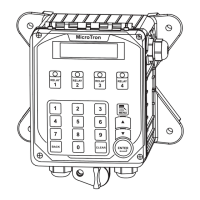13
VI. Maintenance
The only required maintenance for normal uninterrupted operation of your controller is cleaning of the
electrode(s). After initial start up, it is a good idea to clean the electrode frequently until a schedule based on
need has been developed. Since each application is unique, it is dicult to estimate the required frequency
of cleaning. The rst cleaning should take place after about one week of the system being on line.
To determine the required cleaning frequency, record the reading on the controller before the electrode is
removed for cleaning. After cleaning, record the new reading. If a change is observed in the two readings,
the electrode was dirty. The more signicant the change, the dirtier the electrode. If no change occurs,
cleaning needs to be done less often.
Conductivity Electrode Cleaning Procedure
1. Record the current conductivity reading.
2. Turn o water ow through the electrode loop, bleed pressure from the line and remove
electrode.
3. Use a clean cloth and a mild cleaning solution to remove loose dirt etc., from the at
surface of the electrode.
4. If the electrode has deposits such as scale attached to the electrode surface a more
aggressive cleaning approach will be needed. There are several ways to do this, the
preferred method being the one that is easiest for the user.
A. Use a mild acid solution to dissolve deposits.
B. Lay a piece of sandpaper (200 grit or ner) on a at surface such as a bench
top. “Sand” electrode to remove stubborn deposits. (Do not wipe surface with
your nger.) Oil from your skin will foul carbon tips.
5. Reinstall the electrode in the system. After the reading stabilizes, calibrate the unit to a
reliable test reading.
Many times an electrode can appear to be clean, but the unit still cannot be calibrated. If this is the case, use
one of the more aggressive electrode cleaning procedures listed in step 4 above. Recheck the calibration
after completion of this procedure. If no change was observed in the reading, replace the electrode. If a
change occurred but the unit still will not calibrate, repeat procedure as many times as necessary.
VII. Troubleshooting
The Advantage MICROtron controller is designed for many years of trouble free operation. Should a problem
occur, refer to the following chart to help identify the problem. If replacement is required, follow the procedures
listed in the Warranty and Factory Service portion of this manual.
SYMPTOM POSSIBLE CAUSE SOLUTION
False reading .................................... Bad or dirty electrode Clean, as needed
Out of calibration Calibrate unit
Will not calibrate ............................... Dirty electrode Clean electrode
Faulty electrode Replace electrode if needed
Faulty wiring to electrode Replace wiring if needed
No system power .............................. Check power source Plug into dierent receptacle
Check fuse Replace as needed
Check connections Make sure ribbon cables are secure
Pulse timer not activating ................. Check wiring Repair as needed
Check external device Repair/replace as needed
Outputs not energized ...................... No ow Check sample line for
clogged pipes or strainers
Check fuse Replace as needed

